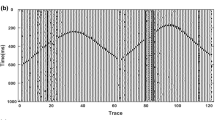Abstract
Picking first arrivals is a fundamental but not easy task in the oil seismic exploration, especially in situations where the signal-to-noise ratios are very low. The paper proposed a new picking algorithm with the emerging new graph signal processing technology in the signal processing field. Fundamentally, first arrival picking is actually as a problem to recognize direct seismic waves among background noises. It is apparently that background noises and the direct waves are from different sources, and therefore, there is no connectivity among them, which formulates the fundamentals of the proposed method. With the help of graph signal processing theory, such non-connectivity is fully explored and cast into an optimization problem for picking the first arrivals in oil exploration. From simulations and real measurements results, the proposed method is validated for first arrival picking with good performances, especially in situations with low signal-to-noise ratios.





Similar content being viewed by others
References
Ma M, Wang S, Yuan S, Wang J, Wen J (2017) Multichannel spatially correlated reflectivity inversion using block sparse bayesian learning. Geophysics 82(4):V191–V199. https://doi.org/10.1190/geo2016-0366.1
Flagg UG, Yarman CE (2016) First-arrival travel time tomography foran isotropic media using the adjoint-state method. Geophysics 81(4):R147–R155. https://doi.org/10.1190/geo2015-0463.1
de Melo FX, Borges GA, Soares JEP (2008) Automatic wave group identification on deep seismic refraction data using SMF clustering. IEEE Geosci Remote Sens Lett 5(4):687–690. https://doi.org/10.1109/LGRS.2008.2002643
Galiana-Merino JJ, Rosa-Herranz JL, Parolai S (2008) Seismic phase picking using kurtosis-based criterion in the stationary wavelet domain. IEEE Trans Geosci Remote Sens 46(11):3815–3826. https://doi.org/10.1109/tgrs.2008.2002647
Fesseha Woldearegay A, Jaiswal P, Simms AR, Alexander H, Bement LC, Carter BJ (2012) Ultrashallow depth imaging of a channel stratigraphy with first-arrival travel time inversion and prestack depth migration: a case history from bull creek, oklahoma. Geophysics 77(2):B87–B96. https://doi.org/10.1190/geo2011-0218.1
Hatherly PJ (1982) A computer method for determining seismic first arrival times. Geophysics 47(10):1431–1436. https://doi.org/10.1190/1.1441291
Luo S, Qian J, Zhao H (2012) Higher-order schemes for 3d first-arrival traveltimes and amplitudes. Geophysics 77(2):T47–T56. https://doi.org/10.1190/geo2010-0363.1
Jiao L, Moon WM (2000) Detection of seismic refraction signals using a variance fractal dimension technique. Geophysics 65(1):286–292. https://doi.org/10.1190/1.1444719
Sabbione JI, Velis D (2010) Automatic first-breaks picking: new strategies and algorithms. Geophysics 75(4):V67–V76. https://doi.org/10.1190/1.3463703
Mousa WA, Al-Shuhail AA, Al-Lehyani A (2011) A new technique for first-arrival picking of refracted seismic data based on digital image segmentation. Geophysics 76(5):V79–V89. https://doi.org/10.1190/geo2010-0322.1
Basler-Reeder K, Louie J, Pullammanappallil S, Kent G (2016) Joint optimization of vertica component gravity and p-wave first arrivals by simulated annealing. Geophysics 81(4):ID59–ID71. https://doi.org/10.1190/geo2015-0643.1
Romero D, Ma M, Giannakis GB (2017) Kernel-based reconstruction of graph signals. IEEE Trans Signal Process 65(3):764–778. https://doi.org/10.1109/TSP.2016.2620116
Mei J, Moura MF (2016) Signal processing on graphs: causal modeling of unstructured data. IEEE Trans Signal Process PP(99):1. https://doi.org/10.1109/tsp.2016.2634543
Segarra S, Marques AG, Leus G, Ribeiro A (2016) Reconstruction of graph signals through percolation from seeding nodes. IEEE Trans Signal Process 64(16):4363–4378. https://doi.org/10.1109/TSP
Behjat H, Richter U, Ville DVD, Sornmo L (2016) Signal-adapted tight frames on graphs. IEEE Trans Signal Process 64(22):6017–6029. https://doi.org/10.1109/TSP.2016.2591513
Huang W, Goldsberry L, Wymbs NF, Grafton ST, Bassett DS, Ribeiro A (2016) Graph frequency analysis of brain signals. IEEE J Sel Top Signal Process 10(7):1189–1203. https://doi.org/10.1109/JSTSP.2016.2600859
Zheng X, Tang YY, Pan J, Zhou J (2016) Adaptive multiscale decomposition of graph signals. IEEE Signal Process Lett 23(10):1389–1393. https://doi.org/10.1109/LSP.2016.2598750
He K, Stankovic L, Liao J, Stankovic V (2016) Non-intrusive load disaggregation using graph signal processing. IEEE Trans Smart Grid PP(99):1. https://doi.org/10.1109/tsg.2016.2598872
Bera D, Chakrabarti I, Pathak S, Karagiannidis G (2016) Another look in the analysis of cooperative spectrum sensing over nakagami-m fading channels. IEEE Trans Wirel Commun PP(99):1. https://doi.org/10.1109/twc.2016.2633259
Tremblay N, Borgnat P (2016) Subgraph-based filterbanks for graph signals. IEEE Trans Signal Process 64(15):3827–3840. https://doi.org/10.1109/TSP.2016.2544747
Zhang D, Liang J (2017) Graph-based transform for 2-d piecewise smooth signals with random discontinuity locations. IEEE Trans Image Process PP(99):1. https://doi.org/10.1109/tip.2017.2661399
Fracastoro G, Magli E (2017) Steerable discrete fourier transform. IEEE Signal Process Lett PP(99):1. https://doi.org/10.1109/lsp.2017.2657889
Sandryhaila A, Moura JMF (2014) Discrete signal processing on graphs: frequency analysis. IEEE Trans Signal Process 62(12):3042–3054. https://doi.org/10.1109/TSP.2014.2321121
Xu X, He L, Lu H, Shimada A, Taniguchi Ri (2016) Non-linear matrix completion for social image tagging. IEEE Access PP(99):1. https://doi.org/10.1109/access.2016.2624267
Author information
Authors and Affiliations
Contributions
QJZ and MYZ contributed to conceptualization; QJZ contributed to methodology; QJZ contributed to software; MYZ was involved in validation; MYZ contributed to formal analysis; QJZ was involved in investigation; MYZ contributed to resources; MYZ was involved in data curation; QJZ was involved in writing—original draft preparation; MYZ contributed to writing, review and editing; QJZ was involved in visualization; MYZ was involved in supervision.
Corresponding author
Ethics declarations
Conflict of interest
The authors declare no conflict of interest.
Additional information
Publisher's Note
Springer Nature remains neutral with regard to jurisdictional claims in published maps and institutional affiliations.
Rights and permissions
About this article
Cite this article
Zhang, QJ., Zhai, MY. First arrivals picking based on graph signal theory. Neural Comput & Applic 32, 1629–1637 (2020). https://doi.org/10.1007/s00521-019-04209-6
Received:
Accepted:
Published:
Issue Date:
DOI: https://doi.org/10.1007/s00521-019-04209-6




